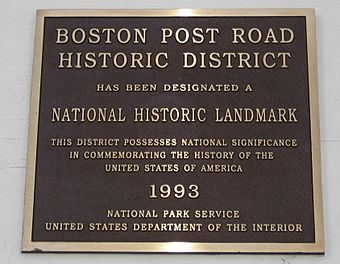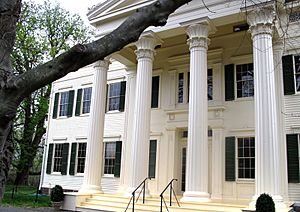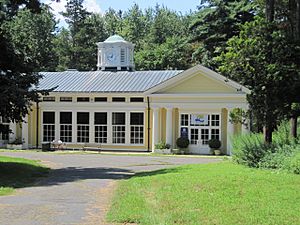Boston Post Road Historic District (Rye, New York) facts for kids
|
Boston Post Road Historic District
|
|

The National Park Service designated the Boston Post Road Historic District in 1993
|
|
| Lua error in Module:Location_map at line 420: attempt to index field 'wikibase' (a nil value). | |
| Location | Rye, New York |
|---|---|
| Built | 1838-1854 |
| Architect | Multiple |
| Architectural style | Gothic Revival, Greek Revival |
| NRHP reference No. | 82001275 |
Quick facts for kids Significant dates |
|
| Added to NRHP | October 29, 1982 |
| Designated NHLD | August 30, 1993 |

The Boston Post Road Historic District is a special area in Rye, New York. It covers about 286 acres and is made up of five important properties. This district is recognized as a National Historic Landmark, which means it's a place with great historical value to the United States.
Inside this district, you'll find three large, old mansions built before the American Civil War. These homes are famous for their unique architecture. There's also a very old site, over 10,000 years old, where Paleo-Indians (early Native Americans) once lived. The district also includes a private cemetery and a nature preserve.
This historic area is one of only 11 National Historic Landmark Districts in New York State. It's the only one in Westchester County. The district touches the Boston Post Road, which is one of the oldest roads in the country. You can even see an old stone marker that says "24," inspired by Benjamin Franklin's original mile markers. The district stretches all the way to Milton Harbor on Long Island Sound.
Two of the main buildings in the district are designed in the Greek Revival style. The third important building is a Gothic Revival structure. It was designed by a famous architect named Alexander Jackson Davis. This district is also very important for understanding the history of Native Americans, European Americans, and African Americans. It was named a National Historic Landmark in 1993.
Contents
What Makes Up the District?
The Boston Post Road Historic District includes several important buildings, structures, and natural areas. Each part helps tell the story of this special place.

The Jay Estate (Built 1745 and Earlier)
The Jay Estate is a 23-acre property with historic buildings, gardens, and beautiful landscapes. A group called the Jay Heritage Center is working to restore it.
A Place of Civil Rights History
In 2004, the Jay Estate was added to the Westchester County African American Heritage Trail. This was because of its connection to John Jay, one of America's Founding Fathers. John Jay worked hard to end slavery in New York State, starting in 1777. He was the founder and president of the Manumission Society of New York. As governor, he signed a law in 1799 to abolish slavery. It's important to know that while he fought against slavery, he also had enslaved African Americans working on his estates until 1810. Free African Americans also worked there for wages.
Recognized for its Importance
The Jay Estate became a member site of the Hudson River Valley National Heritage Area in 2009. This was due to its important buildings and its role in the environmental movement. It's also linked to famous Americans and big social issues, like the fight to end slavery. In 2013, Governor Andrew Cuomo added the site to New York State's "Path Through History." This shows its continuing importance for understanding Civil Rights in New York.
The Peter Augustus Jay Mansion
At the heart of the property is the 1838 Peter Augustus Jay Mansion. This house is owned by the Jay Heritage Center. It's one of two Greek Revival homes in the historic district. The mansion stands where John Jay's childhood home once was, with similar views. John Jay's house was built on the foundation of an even older 18th-century farmhouse. His oldest son, Peter Augustus Jay, replaced it with the current mansion in the early 1800s. The restoration of this house is a special project called Save America's Treasures.
Other Buildings and Features at the Jay Estate
- 1907 Van Norden Carriage House: This bright yellow building was designed by Frank A. Rooke. It now serves as the Visitor Center and is open to the public.
- 1907 Zebra House: Also designed by Frank A. Rooke.
- Tennis House: Built in 1917 or earlier.
- Cottage on Barlow Lane: An old cottage from the 18th century or earlier.
- Gardens: The gardens were designed by the Jay family and others. They include unique dry-laid stone walls called ha-ha walls from 1822. These gardens are currently being restored.
Jay Family Cemetery (Established 1806)
The Jay Cemetery is a private cemetery that covers about 3 acres. John Jay was buried here in 1829. This cemetery is not open to the public.
Lounsbury (Built 1831)
Lounsbury is also known as the Parsons Estate. It's the second Greek Revival home in the district. It has a famous library designed by Delano & Aldrich. This property is privately owned and not open to the public.
Buildings at Lounsbury
- Gardener's Cottage
- Carriage House and Stable
- Outbuilding with five bays
- Poultry and Wood House
- Greenhouse
Whitby Castle (Built 1854)
Whitby Castle is a Gothic Revival style building. It was once the home of the Chapman family. Today, it is used as the City of Rye Golf Club. It was designed by the architect Alexander Jackson Davis.
Buildings at Whitby Castle
- Caretaker's house
Marshlands Conservancy (Established 1966)
The Marshlands Conservancy is a nature preserve managed by Westchester County Parks. It has many different natural areas, like ponds, streams, meadows, woodlands, salt marshes, and freshwater wetlands. These habitats attract many different plants and animals.
Historically, this land was part of the larger Jay Estate and the nearby Parsons Estate. It became a park through two gifts of land in the 20th century. In 1997, Westchester County officially set aside this 147-acre area. It was designated as a nature and wildlife preserve for quiet activities like walking and observing nature. The Marshlands Conservancy is also recognized as an Important Bird Area.





